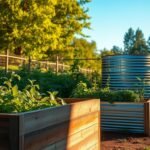Ever wondered how to get more food from your growing space while keeping plants thriving? The secret lies in smart strategies that balance what you grow, where you plant it, and when. By moving crops systematically across seasons, you’ll naturally reduce pests and boost soil health—no magic required.
Think of your plot as a living system. Different plants take nutrients from the earth, but they also give back in unique ways. Heavy feeders like tomatoes benefit from being followed by nitrogen-fixing beans, while deep-rooted crops break up compacted soil for shallow-rooted greens. This rhythm keeps your dirt rich and productive.
Timing matters just as much as placement. You’ll need a clear method to track what grew where each season. A simple notebook or digital tool helps avoid repeating the same plants in one spot year after year. This prevents diseases from settling in and ensures nutrients aren’t drained.
With thoughtful organization, your beds become a self-sustaining powerhouse. You’ll spend less time battling bugs or weeds and more time enjoying fresh, homegrown meals. Ready to turn your outdoor space into a well-oiled machine? Let’s dive into the details.
Planning Your Vegetable Garden: Location, Size, and Layout
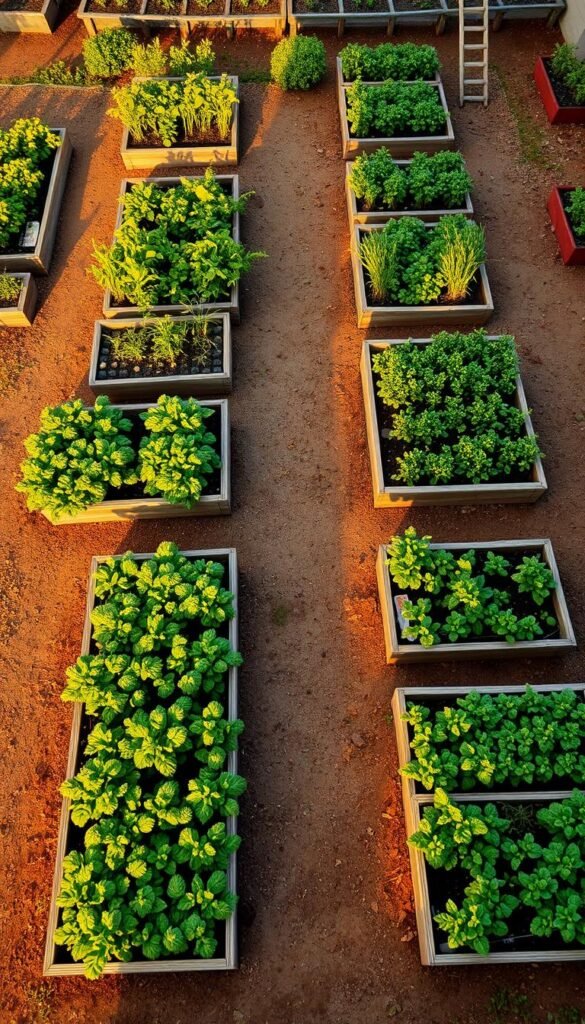
Getting your growing area right starts with smart positioning. Where you place your plot determines how well your plants thrive and how much you harvest. Let’s break down the essentials for creating a productive setup.
Choosing the Ideal Location for Sunlight and Soil Quality
Sunlight is your best friend here. Aim for spots getting 6+ hours of direct sun daily. Leafy greens tolerate some shade, but tomatoes and peppers demand full exposure. Check your space throughout the day to avoid shadowy surprises.
Next, test your ground. Squeeze a handful of dirt—if it crumbles easily, you’re golden. Sticky clay? Mix in compost to improve drainage. Add organic matter each fall or early spring to keep nutrients flowing. Avoid low spots where water pools, and steer clear of tree roots that hog resources.
Designing Efficient Raised Beds and Garden Spaces
Raised beds solve many challenges. They warm faster in cool weather, letting you plant sooner. Keep them 3-4 feet wide so you can reach the center without stepping on the soil. This prevents compaction and protects delicate roots.
Start small if you’re new. A 4×8-foot area gives enough room for basics like lettuce and herbs. Arrange taller crops (like pole beans) on the north side to avoid shading shorter neighbors. Whether you choose rows or blocks, leave paths wide enough for easy movement.
Remember: Good planning now means fewer headaches later. Your future self will thank you when harvest time rolls around!
Essential Crop Rotation Techniques for a Healthy Garden
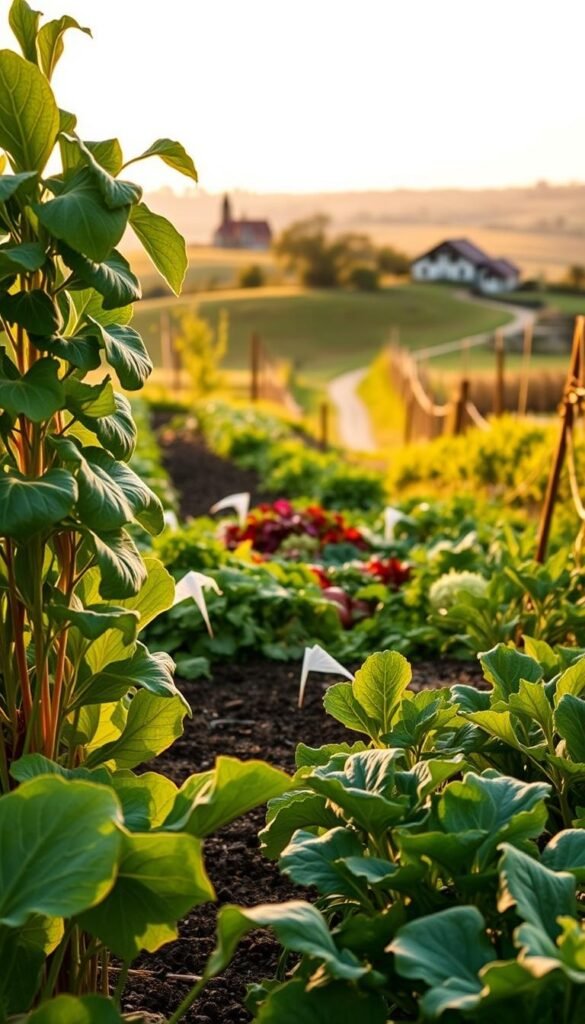
Keeping your soil thriving year after year requires more than just adding compost. Strategic plant movement creates natural defenses against threats while optimizing earth’s resources. Let’s explore how smart swaps protect your harvests.
Break the Cycle of Hidden Threats
You’ll cut disease risks by switching plant locations each season. Many harmful organisms linger where their favorite hosts grow. Moving tomato relatives to new spots, for example, starves fungi that target nightshades.
Pests struggle when their breeding grounds disappear. Root-knot nematodes lose steam if you replace susceptible crops with marigolds or grains. This approach works wonders for rotating crops in tight areas where space limits options.
Feed the Earth While Feeding Yourself
Alternate heavy and light feeders to maintain soil vitality. After nitrogen-hungry corn, plant peas to replenish what’s missing. Deep-rooted carrots break up compacted earth, preparing beds for shallow lettuce.
Focus on plant families rather than individual species. The cabbage clan (broccoli, kale) always follows legumes in a 4-year cycle. Track placements using simple charts or apps—your future harvests depend on this rhythm.
Garden Layout Vegetable Planning: Tracking Crop Rotation and Successions
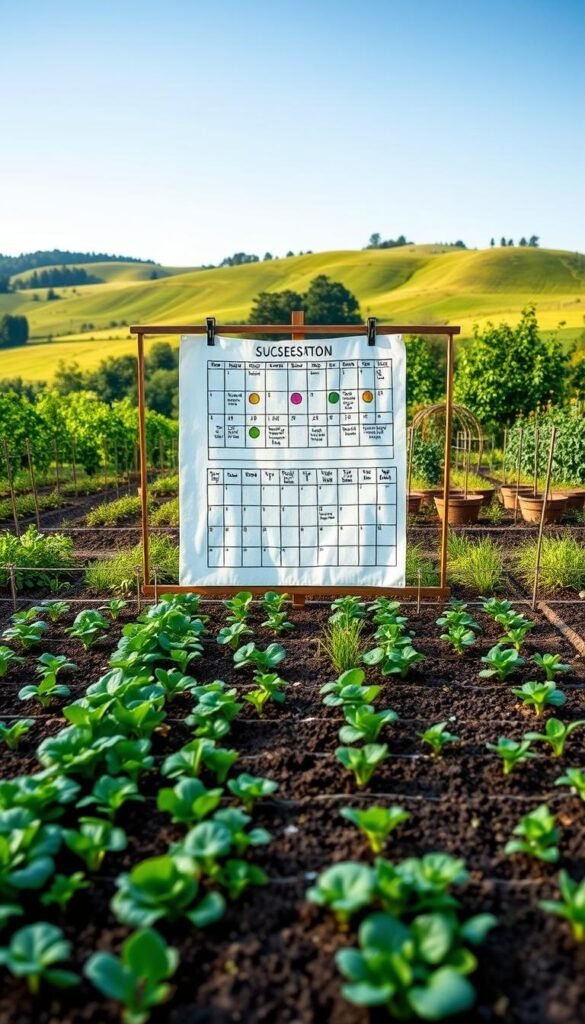
What if your beds could work overtime without exhausting the soil? Smart timing unlocks this superpower. By layering plantings across months, you’ll squeeze every ounce of potential from your space while keeping earth nutrients balanced.
Implementing Successive Planting Strategies
Start with quick growers that thrive in cool weather. Spinach and lettuce burst from the ground in early spring, giving you salads in weeks. When summer heat arrives, yank these greens and pop in bush beans—they love warm soil and mature fast.
After beans finish producing, cool-season stars return for an encore. Sow another round of spinach or kale in late summer. These cold-tolerant varieties sweeten after frost, extending your harvest into fall. Even short growing zones can manage three acts if timed right.
Track maturity dates like appointment reminders. Pull plants the day they bolt or fade to avoid gaps. Stagger seedings every 2-3 weeks for continuous yields. Just ensure each new group belongs to a different plant family than its predecessor.
This rhythm keeps your soil engaged but never drained. You’ll enjoy fresh produce longer while outsmarting pests that target stagnant plantings. More food, less work—now that’s a win-win!
Mapping Your Garden: Creating a Detailed Planting Plan
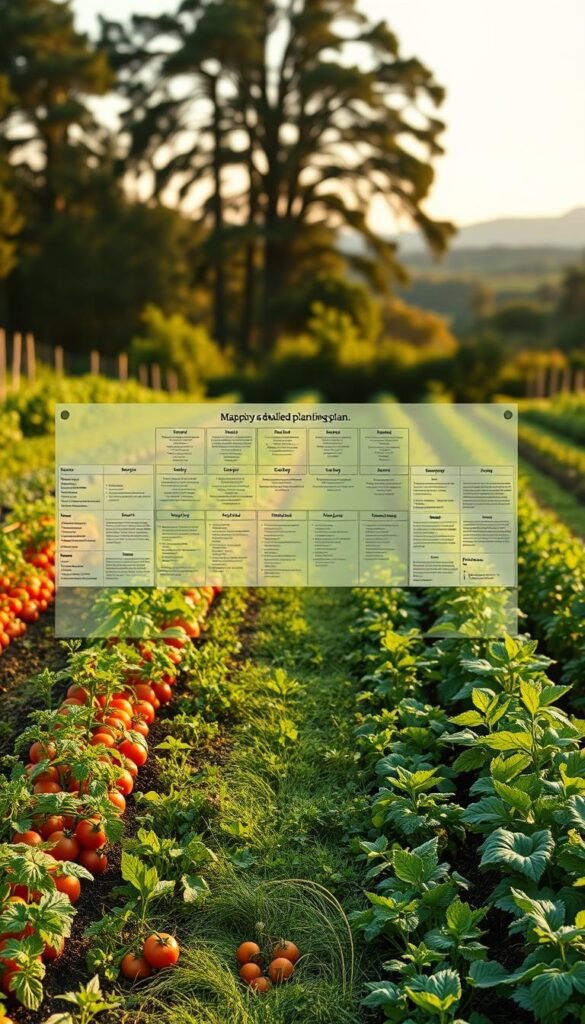
Visualizing your growing space on paper transforms guesswork into precision. A well-crafted diagram becomes your seasonal playbook, showing exactly where each seedling belongs and how your beds evolve through the year.
Sketching and Dividing Your Beds
Start by drawing your plot’s shape with accurate measurements. Graph paper works wonders for hand-drawn maps, while free apps like Planter offer drag-and-drop convenience. Prioritize sun-loving tomatoes and peppers in prime locations, then assign climbing beans to trellis zones.
| Vegetable | Spacing | Notes |
|---|---|---|
| Tomatoes | 24-36″ apart | Needs staking |
| Peppers | 18-24″ apart | Full sun required |
| Onions | 4-6″ apart | Shallow roots |
| Lettuce | 8-12″ apart | Quick harvest |
Leave breathing room between plants using seed packet guidelines as your cheat sheet. Overcrowded greens become bug buffets, while properly spaced crops form natural pest barriers.
Tracking Plant Families and Rotation History
Color-code your map by plant family—nightshades in red, legumes in green. This visual cue helps avoid repeating related species in the same bed next year. “Rotation isn’t just about moving plants—it’s about disrupting pest lifecycles,” notes Iowa State horticulturist Linda Naeve.
Update your diagram yearly to track which beds hosted brassicas or alliums. Digital tools automatically log this data, but a simple notebook works too. When spring arrives, you’ll know exactly where to plant squash after peas or carrots after corn.
Incorporating Succession Planting and Vertical Growth Methods
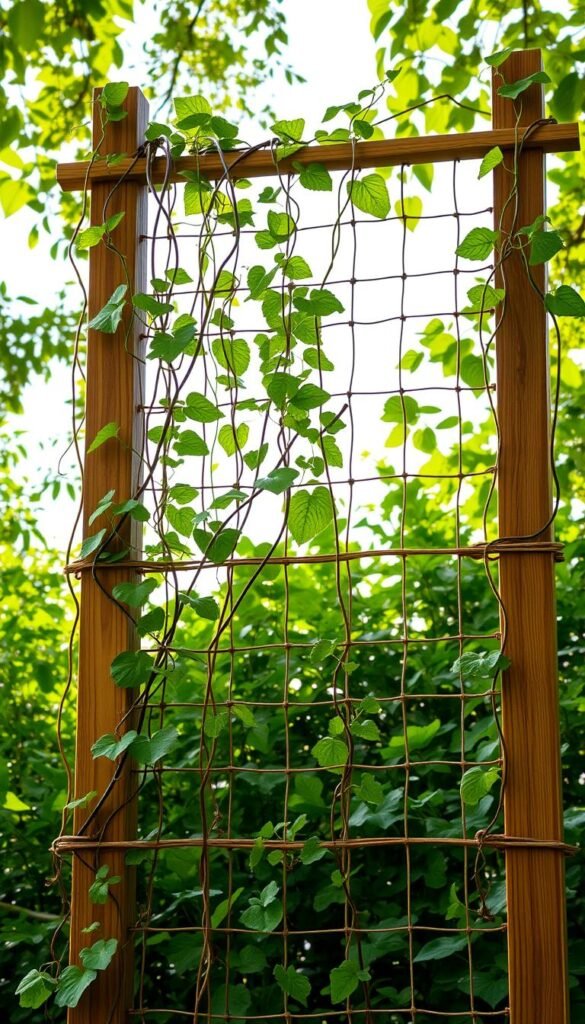
What if you could double your harvest without expanding your plot? By stacking plants upward and timing crops smartly, even small beds become powerhouses. This approach keeps your soil busy while creating natural shade and support systems.
Maximizing Space with Trellises and Vertical Supports
Train peas and pole beans to climb sturdy structures. Place these climbers on the north side of your beds—tall tomatoes won’t block sunlight for shorter peppers or cabbage below. Metal cages or wooden lattices work best for heavy producers like winter squash.
Vining crops need room to stretch. Let pumpkins and melons spill onto pathways instead of crowding beds. “Vertical growth isn’t just about saving space—it improves air circulation and reduces disease,” explains market gardener Jean-Martin Fortier.
| Crop Type | Support Needed | Spacing | Season |
|---|---|---|---|
| Pole Beans | 6-ft trellis | 4″ apart | Summer |
| Indeterminate Tomatoes | Stakes/cages | 24-36″ apart | Spring-Fall |
| Cucumbers | Mesh netting | 12″ apart | Summer |
| Peas | Twine grid | 2″ apart | Spring/Fall |
Pair vertical systems with succession planting strategies for nonstop yields. After spring greens bolt, plant fast-growing carrots or broccoli in their shade. Come fall, swap summer squash with cold-hardy kale—all in the same square footage.
Sturdy supports matter most for tomatoes and peppers. Use thick wooden stakes for plants loaded with fruit. Check ties weekly as stems thicken. With smart planning, your vertical garden becomes a living ladder of abundance!
Wrapping Up Your Garden Planning Journey
You’ve now unlocked the blueprint for transforming your plot into a thriving ecosystem. By mixing smart crop rotation with strategic timing, you create nature’s own defense system against pests and tired earth. Remember: even basic plant shuffling beats repeating the same mistakes year after year.
Nightshades like tomatoes and potatoes demand extra care—keep them moving every four seasons to avoid disease buildup. No need for complex charts if that overwhelms you. Split your space into zones and rotate plant families through them. A simple notebook entry after each harvest keeps future you informed.
Those scribbled notes become gold when planning next year’s bounty. Track what thrived where, which combos fought off bugs, and how your soil responded. This intel lets you tweak strategies instead of starting from scratch each spring.
Stick with these principles, and your efforts will bloom into healthier plants and bigger harvests. You’ll savor fresh meals through summer and stockpile preserved goodness for winter. Now grab those seeds—your best growing season starts today!
